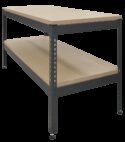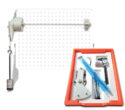Experiment
SM1001

TORSION TESTING MACHINE (30 Nm)
A bench mounted machine to allow students to do torsion tests on different materials.
If you have any questions or you'd like to discuss a product, please call us.
+44 1159 722 611TORSION TESTING MACHINE (30 Nm)
The Torsion Testing Machine is a compact machine, ideal for classroom demonstrations and for safe use by small groups of students. Its frame is a rigid, precision-engineered alloy box-section, supported at each end by adjustable feet. It carries two main parts:
- A ‘strain head’ at one end
- A torque reaction and measurement system at the other.
The specimens fit between the strain head and the torque reaction and measurement system.
The strain head is a 60:1 worm drive reduction gearbox, mounted on a platform. The platform can be moved and locked to any point along the frame. To apply torque, students turn a handle at the input of the gearbox. A keyway allows the output shaft of the gearbox to slide freely along its length. This allows for any change in length of the specimen during the tests and for easy insertion of specimens.
An accurate encoder measures the strain (angular movement) at the strain head. The encoder has a digital display and can connect to TecQuipment’s Versatile Data Acquisition System (VDAS®).
The torque reaction and measurement system includes a torsion shaft supported by bearings. The shaft reacts on a strain-gauged load cell. A digital display shows the force measured by the load cell. The display can connect to VDAS®.
Hexagonal drive sockets hold the test specimens. The sockets fit on the gearbox output shaft and the torsion shaft. TecQuipment supplies two different sizes of drive sockets.
For safety, a clear guard protects the user when they perform destructive tests on standard-size specimens. For increased strain measurement accuracy, use the optional Torsiometer (SM1001a). The increased accuracy is useful to help find the modulus of rigidity (shear modulus). The torsiometer has a digital display of angular movement, calibrated to the strain angle (in radians). The torsiometer can connect to VDAS®.
For quick and reliable tests, TecQuipment can supply the optional VDAS® which gives accurate real-time data capture, monitoring and display, calculation and charting of all important readings on a computer.
Learning outcomes
- Determination of modulus of rigidity (shear modulus) and yield strength (when used with the optional torsiometer)
- Determination of upper and lower yield stresses for normalised steel specimens
- Reversed torsion tests to demonstrate the Bauschinger effect and the effects of residual body and textural stresses on torsional strength
- Comparison of the different elastic and plastic properties of materials (when used with the optional specimens)













